| Home | First Posted: May 30, 2010 Jan 21, 2020 | |
Swimming and Hydrotherapy for Horses and Dogsby Debora Johnson 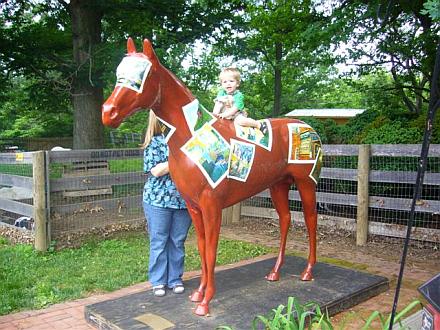 A family and their toddler, Hunter, on his first horse outside the Swim Center 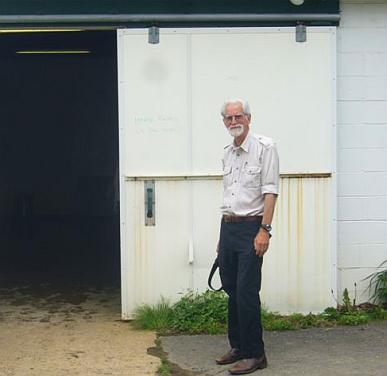 My husband on his way into the Swim Center 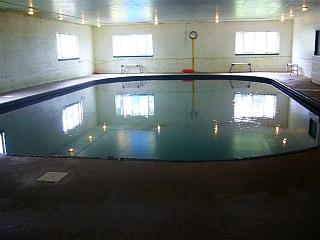 ; ;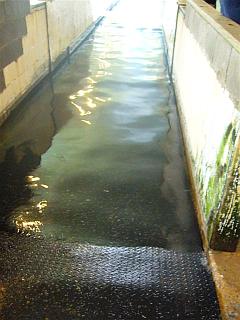 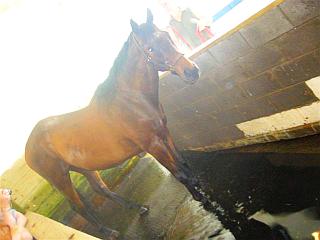 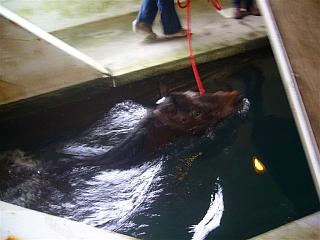 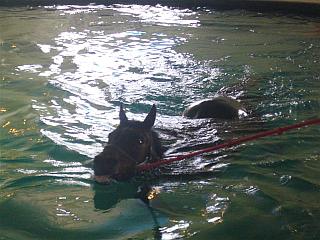 May 29, 2010 my husband, Bill, and I enjoyed the day in Middleburg, Virginia at their 51st Annual Hunt Country Stable Tour. The Northern Virginia Animal Swim Center is a unique facility that was on the tour. It specializes in swimming horses and dogs to get fit and to rehabilitate following injury or surgery. They can swim all year round in the heated, specially designed pools. The large, 12 feet deep pool (180,000 gallons) is for both dogs and horses to do lap workouts, swimming anywhere from 100 yards to over a mile, depending on their fitness level. For more information on the Northern Virginia Animal Swim Center web site follow this link. The information in this article is taken from the Stable Tour brochure and from the Northern Virginia Animal Swim Center web site. Permission was given by Roger, the owner of the facility, for HorseHints to use their website information in this article. The photographs are copyright HorseHints.org.  Roger Collins Swimming provides a weightless environment that promotes a full range of motion and limb movement not attainable with normal exercise. If people think of swimming animals at all they generally associate it with rehabilitation or recovery after an injury. At the Animal Swim Center, more horses swim as a means of conditioning or fitness than for rehabilitative purposes. Swimming provides the ideal medium to achieve, or maintain, a high level of fitness and condition without the dangers and potential injury that are inherent in track and ground workouts. Although ground work is a necessary part of the overall conditioning of the horse, more than 60 percent of ground work can be replaced with a well structured swimming program. This means 60 percent less chance of injury, and for the horse prone to foot, tendon or ligament problems, a better chance to stay sound and be fit for the big event. By reducing the amount of ground work required to get a horse fit you can significantly reduce the potential for injury. Conditioning programs are structured to each individual horse based on the breed, initial physical condition, and the discipline being trained for (racing, eventing, endurance, show, pleasure etc.). Conditioning programs can require 15 to 60 days of swimming depending on the initial fitness of the horse and the frequency of swim sessions. Ground work can be incorporated into the program to round out muscle development and prepare for the return to, or application of, specific training. A typical program will start with the horse swimming approximately 200 yds. (four laps). Over time the number of laps are gradually increased so they are eventually swimming a total of 15 to 30 laps (750 to 1500 yards). Each swimming session is broken up into multiple swims of shorter distances, similar to interval training where the heart-rate and breathing are brought down to normal levels before swimming is continued again. In this way the maximum amount of benefit is obtained from the workout. In terms of the energy and physical demands required of swimming compared to the equivalent demands of ground work, approximately 500 yds. of swimming is equivalent to a 1 mile gallop, of course without the inherent dangers and risks associated with galloping. Swimming also has the benefit of developing muscle groups not attainable with normal ground-based programs. These are primarily the hind end, diaphragm and shoulder muscles. Building the diaphragm promotes stronger and deeper breathing control for better oxygenation of the blood. Building hind end and shoulder muscles gives greater strength and power, providing greater speed, control and balance. It takes only four or five swimming sessions to see and feel the difference. Swimming has proven effective in:
Horses, like all animals, have the natural ability to swim. They do not have to be taught, but they do have to learn water confidence. This generally takes three or four sessions of swimming until the horse is completely comfortable. The horse is led down a gradually descending ramp into the water. Most horses enter the pool with a tug on the lead line or some verbal coaxing from the owner or handler. The first session involves swimming single laps to allow the horse to gain the experience and confidence of entering, swimming and exiting the pool. Horses take to the swimming experience quite readily and after the third or fourth session enter the pool with little or no encouragement required from the handler. The Swimming SessionRegardless of the initial fitness of the horse, the first sessions are limited to four or five laps of the pool. This is to allow the horse to adapt to the swimming and develop the new muscles being used in the swimming process. One lap of the pool is about 50 yards. Each time the horse swims, the swimming time and distance are increased to where the horse may be swimming anywhere between 6 to 30 laps of the pool. The number of laps depends on whether the horse is swimming for conditioning, rehabilitation or just maintaining a level of fitness. Swimming ProgramSwimming programs are structured for each horse based on the breed, initial fitness level, the speed at which they swim, the discipline being trained for and whether the horse is being conditioned for fitness or recovering from injury. The Center offers comprehensive swimming programs that include full board and care. Owners and trainers may also trailer their horse to the Center and swim to their own developed schedule. Center staff are always available to swim the horses, teach owners/handlers to swim their own horses and assist or advise handlers on achieving the best results. Swimming can replace a significant amount of ground work normally required to get, or maintain a horse fit. This is particularly important when ground conditions make riding dangerous both for the horse and rider or if the horse is prone to feet problems like laminitis, bruising, navicular or shoeing problems. Once the horse has completed the initial swimming sessions they never forget and take readily back to swimming again even after years of no swimming. |